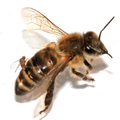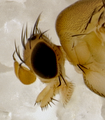Apocephalus borealis
| Apocephalus borealis | ||||||||||||
|---|---|---|---|---|---|---|---|---|---|---|---|---|

Adult female Apocephalus borealis |
||||||||||||
| Systematics | ||||||||||||
|
||||||||||||
| Scientific name | ||||||||||||
| Apocephalus borealis | ||||||||||||
| Brues , 1924 |
Apocephalus borealis is aspecies of fly foundin North America from the family of humpback flies (Phoridae), which mainly parasitizes bumblebees , but also honey bees and some wasp species .
description
Apocephalus borealis including the ovipositor has a body length of 2.2 mm. It is pale yellow in color. The middle part of the abdomen is colored orange. The first segment is brownish with a pale rear edge, on the second segment there is a brownish spot on the side. The third and fourth segments each show a larger dark area. The fifth segment is completely dark, the sixth only at the front. The ovipositor is brown-black with a lighter tip. The legs are pale brownish yellow. The wings are transparent with pale dark veins .
Way of life
A. borealis parasitized honey bees until January 2012 only in California and South Dakota , elsewhere it primarily parasitizes bumblebees . The female flies lay with her ovipositor eggs in the abdomen of the bees, where up to 13 larvae can develop. The larvae attack the host bee's brain , disorient it and cause it to leave the hive, usually at night. This behavior favors the spread of the flies and leads to the premature death of the host. Outside of the hive, the bees wander around disoriented or show other unusual behavior patterns. Older larvae living in the bees' neck area can also lead to the decapitation of their host bee, from which their genus name apocephalus is derived.
Some scientists suspect that Apocephalus borealis is a possible cause of the spread of the colony collapse disorder . The decisive factor is not the loss of individual bees by the parasitic larvae, but the transmission of bacteria and fungi such as Nosema ceranae , the pathogen that causes nosemosis . Apocephalus borealis is an important vector in this .
Apocephalus borealis belongs to the subgenus Mesophora within the genus Apocephalus . While the other subgenus specialize in ants , the species of the subgenus Mesophora parasitize on various other insects and arachnids. So far, only Apocephalus borealis has been found on honey bees .

Colloquially, bumblebees and honeybees infected by A. borealis are sensationally referred to as "zombie bees" because of their behavior reminiscent of zombies .
photos
Laying spine of a boreal artery
literature
- Silke Beckedorf: Fly against bees . In: German bee journal: forum for science and practice . No. 2 . German Bauernverlag, February 2012, ISSN 0943-2914 , p. 5 .
- CT Brues: Notes on Some New England Phoridæ (Diptera). In: Psyche: A Journal of Entomology. 31, 1924, pp. 41-44. doi : 10.1155 / 1924/42175 .
Web links
- Dirk Förger: Fly larvae turn bees into zombies. on Wissenschaft Aktuell (accessed on January 27, 2012)
- ZomBee Watch. Citizen science project tracking the honey bee parasite Apocephalus borealis.
Individual evidence
- ^ Charles T. Brues: Notes on Some New England Phoridoe (Diptera). In: Psyche: A Journal of Entomology. 31, 1924, pp. 41-44. ( Online )
- ↑ Silke Beckedorf: Fly versus bee . In: German bee journal: forum for science and practice . No. 2 . German Bauernverlag, February 2012, ISSN 0943-2914 , p. 5 .
- ^ A b Andrew Core, Charles Runcke, Jonathan Ivers, Christopher Quock, Travis Siapno, Seraphina DeNault, Brian Brown, Joseph DeRisi, Christopher D. Smith, John Hafernik: A new threat to honey bees, the parasitic phorid fly Apocephalus borealis. PLoS ONE 7, 1, e29639, 2012 doi : 10.1371 / journal.pone.0029639 (English)
- ↑ Andy Coghlan: Parasitic fly could account for disappearing honeybees New Scientist , 2846, January 3, 2012 (English). Retrieved February 7, 2012
- ^ CT Brues: Notes on Some New England Phoridæ (Diptera) . In: Psyche: A Journal of Entomology . 31, 1924, pp. 41-44. doi : 10.1155 / 1924/42175 .
- ↑ Dirk Förger: Fly larvae turn bees into zombies. In: Wissenschaft aktuell. January 4, 2012, accessed February 19, 2019 .




